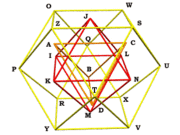Digital Math
A Digital Mathematics: Heuristics for Teachers
Welcome
This Digital Mathematics curriculum was pioneered in the Silicon Forest, around Willamette Valley and north to Seattle and somewhat onward.
What you will find here is a 10,000 foot overview, a view from space as it were, with a sample lesson plan or two.
Mostly we're looking for a way to divvy up a large number of topics in a segmented way that preserves their inter-relationships and encourages further exploration. You may apply what you learn here without dropping your existing materials.
This is "math with a time line" meaning stories are important, meaning lore, epics and sagas, not just "story problems". This lore is not all recounted here, but there's an emphasis on storytelling as relevant to math teaching. We celebrate our heroes and heroines, our teachers, their accomplishments and adventures.
What is Digital Mathematics?
In the historical context in which it arose, most teenagers were expected to take at least three years of mathematics to get a high school diploma and those considered college bound were encouraged to take calculus. This "single track" regime seemed oppressive to many students as well as educators. We were losing a lot of talent for lack of any alternatives.
Here were some shortcomings DM was designed to address:
- A lot of discrete math topics were given short shrift and computer programming of any kind was relegated to an "elective" category, meaning studying programming would not help satisfy that three year requirement. Scientific calculators dominated the scene.
- Mathematics had also become an ahistorical discipline, somewhat devoid of a time line. Skills were taught in a vacuum, with little attention to contextualizing narrative. Lack of context deprived the subject of much of its intrinsic power and interest, was bad for morale.
- Spatial geometry was weak to non-existent, with a few volume formulas getting most of the attention. Few students learned much of the nomenclature, or had many ideas about polyhedra.
- Mathematics had become stereotyped as a set of sedentary activities, typically performed only indoors.
Given how many students were discouraged by these options, or lack thereof, some curriculum writers (such as myself) started designing a new mathematics track that would offer a different range and mix of topics, an alternative to what was traditionally available.
This Wikieducator site was one manifestation of this movement.
The Martian Math component is especially influenced by some late 1900s pedagogical innovations in spatial geometry regarded as too radical to include in the mass marketed textbooks well into the 21st century.
Supermarket Math advances the notion that the basics of the Internet and e-commerce should be explained, with Structured Query Language at least introduced to advance the storytelling, to make it real. These basics may be shared with or without access to computers, however given the Silicon Forest context, some computer and Internet use is presumed.
Neolithic Math provides a way to get back to basics, but without sacrificing the heuristics now believed to have guided many an ancient culture. Even though the tools were relatively primitive, we have ample evidence that geographic and astronomic information was embedded in these arts and crafts.
Casino Math, like Martian Math, might be renamed in your region, given many ethnic groups place moral restrictions against gambling. In our own bioregion, games of chance were used by the various local sovereignties to raise funds (e.g. Grand Ronde, Tulalip, Stillaguamish), most especially for education, so we considered it hypocritical to not discuss this openly in a curriculum context. Sharing realistically about "the odds" is in itself a deterrent to unwise risk taking.
How these four modules interconnect is taken up within each. The choice of four is by design, as these comprise the vertices of a tetrahedron and six relationships.
Tetrahedra are especially important in Martian Math from a geometric perspective, whereas "connecting the dots" (via the six relationships) is a metaphor for "systematic thinking" and/or "thinking in the round" -- what we mean by heuristics.
Polyhedra Matter in Mathematics
The emphasis on polyhedra is quite pronounced through all four of these modules. For example, when it comes to SQL, you might imagine retrieving them from a database based on simple filters, getting only the Platonics or Archimedeans as result sets, or those with only triangular faces etc. (assume a finite inventory, for the purposes of this exercise).
In games of chance, you might think of them as dice, random generators.
Along the Neolithic to Martian time line (distant past to distant future) they crop up all along the way.
"Things with insides and outsides" are the generic constituents of any vista. Any physical object is a polyhedron or might be rendered as such. The tetrahedron is the simplest polyhedron.
Exhaustive or encyclopedic treatment of the included topics is not a goal. Preservation of valuable heritage (much of it falling through the cracks along the "analog math" track) is a goal.
Current Exhibits
A rotating showcase of Digital Math related projects.
Martian Math at Reed College (2018)
Martian Math at Reed College (2009)
Digital Mathematics Jupyter Notebooks (2018)
